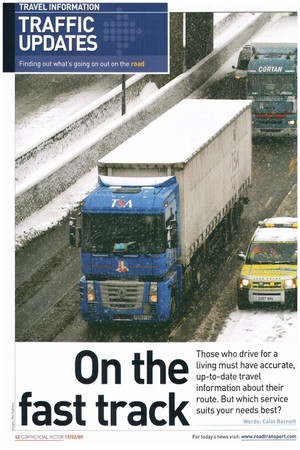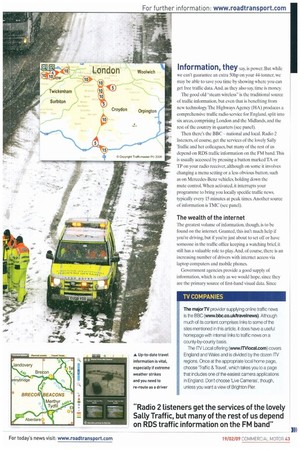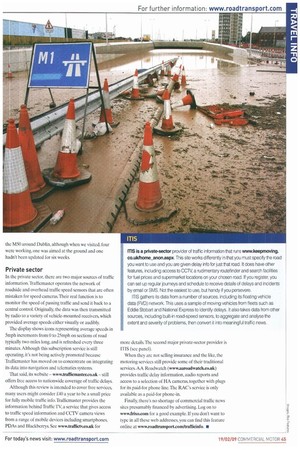On the
Page 42

Page 43

Page 44

Page 45

If you've noticed an error in this article please click here to report it so we can fix it.
fast track
Those who drive for a living must have accurate, up-to-date travel information about their route. But which service suits your needs best?
Words: Colin Barnett
Information, they say, is povver. But while we can't guarantee an extra 50hp on your 44-tonner, we may be able to save you time by showing where you can get free traffic data. And, as they also say, time is money.
The good old "steam wireless" is the traditional source of traffic information, but even that is benefiting from new technology. The Highways Agency (HA) produces a comprehensive traffic radio service for England, split into six areas, comprising London and the Midlands, and the rest of the country in quarters (see panel).
Then there's the BBC —national and local. Radio 2 listeners, of course, get the services of the lovely Sally Traffic and her colleagues, but many of the rest of us depend on RDS traffic information on the FM hand. This is usually accessed by pressing a button marked TA or TP on your radio receiver, although on some it involves changing a menu setting or a less obvious button, such as on Mercedes-Benz vehicles, holding down the mute control. When activated, it interrupts your programme to bring you locally specific traffic news, typically every 15 minutes at peak times. Another source of information is TMC (see panel).
The wealth of the Internet
The greatest volume of information, though, is to be found on the internet. Granted, this isn't much help if you're driving, but if you're just about to set off or have someone in the traffic office keeping a watching brief, it still has a valuable role to play. And. of course, there is an increasing number of drivers with internet access via laptop computers and mobile phones.
Government agencies provide a good supply of information, which is only as we would hope, since they are the primary source of first-hand visual data. Since highways management is a function devolved to the regional government bodies, information services are provided on the same regional basis, although there are plans to combine them.
Camera facilities
In England. the HA publishes traffic information. It has a number of addresses that lead to the same service we recommend www.trafficengland.com.
The homepage carries a ticker with headline details of major incidents and a map to select one of seven regions for more detailed information, The regional map shows motorways and major trunk roads, with switches to show data such as delays, incidents, weather, gantry and roadside sign displays and roadworks. current and scheduled. Access to motorways is available, but it's well hidden. You need to go to 'Event Information' then 'Current Motorway Information', where you are invited to select your motorway and a similar set of switches, including one for cameras.
The camera facility is good when it's working. but cameras are often out of service and the feed is always turned off at the scene of an incident. The camera overlooking the oversize vehicle bay at the M25 clockwise services at Clacket Lane will particularly appeal to BigLorryBloggers.Traffic England doesn't provide SMS alerts, but it does offer an RSS feed. At the time of writing, the HA was running a beta test on an improved website at www.beta.trafticengland.com and was inviting feedback-this could be your chance to shape the future.
In Wales, it's www.traffic-wales.com, which is provided by Traffic Wales, the Welsh Assembly Government traffic information service. One level in from the home page, with its scrolling headlines, takes you to the national map that shows delays, roadworks and camera locations.
These are mainly on M4 and A55 corridors to the ports, but also Heads of the Valley road, A470 up to Merthyr Tydfil, A449 around Newport and a lonesome one at the Storey Arms on top of the Brecon Beacons. The implementation of the camera view is one of the best, just hovering your mouse over the map icon instantly changes the camera view. The Welsh site also provides RSS, but here you can register to receive email and SMS alerts as well.
The home nations
Traffic Scotland, www.trafficscotland.org, has a similar set-up to England, although its camera function is almost as good as the Welsh. That said, though, you have to click on the icon to change the view.
Traffic Watch Northern Ireland (www.trafficwatdmi.com) covers the fourth of the home nations. This is a much simpler site than the others, with traffic news provided as a list rather than on a map. It has just four cameras, around Belfast centre, hut they are live video feeds rather than the usual still image refreshed every three minutes or so.
A similar service is provided in Ireland by National Roads Authority (www.nratraffic.ie). The map of Ireland mostly gives weather reports, but there are 15 cameras on the M50 around Dublin, although when we visited, four were working, one was aimed at the ground and one hadn't been updated for six weeks.
Private sector
In the private sector, there are two major sources of traffic information.Trafficmaster operates the network of roadside and overhead traffic speed sensors that are often mistaken for speed cameras.Their real function is to monitor the speed of passing traffic and send it back to a central control, Originally, the data was then transmitted by radio to a variety of vehicle-mounted receivers, which provided average speeds either visually or audibly.
The display shows icons representing average speeds in 5mph increments from 0 to 25mph on sections of road typically two miles long, and is refreshed every three minutes. Although this subscription service is still operating, it's not being actively promoted because Trafficmaster has moved on to concentrate on integrating its data into navigation and telematics systems.
That said, its wehsite — www.trafficmaster.co.uk — still offers free access to nationwide coverage of traffic delays.
Although this review is intended to cover free services, many users might consider £40 a year to be a small price for fully mobile traffic info.Trafficrnaster provides the information behind Traffic TV, a service that gives access to traffic speed information and CCTV camera views from a range of mobile devices including smartphones. PDAs and Blackberry& See www.traffictv.co.uk for more details. The second major private-sector provider is ITIS (see panel).
When they are not selling insurance and the like, the motoring services still provide some of their traditional services. AA Roadwatch (www.aaroadwatch.co.uk) provides traffic delay information, audio reports and access to a selection of HA cameras, together with plugs for its paid-for phone line. The RAC's service is only available as a paid-for phone-in.
Finally, there's no shortage of commercial traffic news sites presumably financed by advertising. Log on to www.frixo.com for a good example. If you don't want to type in all these web addresses, you can find this feature online at www.roadtransport.com/trafficinfo. •
















































































































































